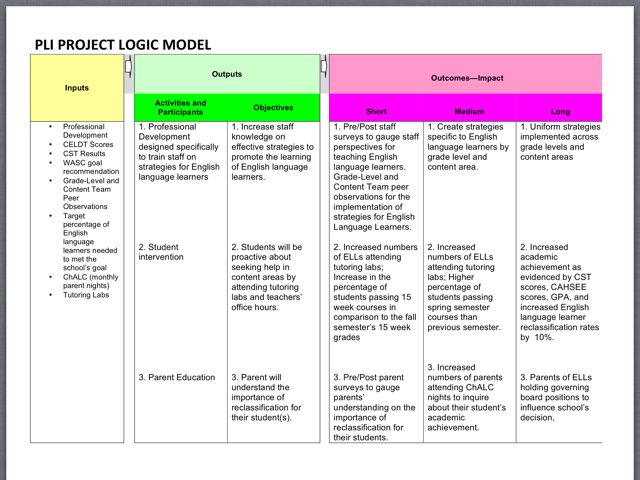Leadership Project: Addressing English Language Learners' Academic Gap
Introduction
English language learners (ELLs) at the Academic Leadership Community High School (ALC) are not attaining the same academic performance levels as other students on campus. English language learners are not scoring above basic on most CST exams, passing core academic classes, nor are they reclassifying at expected rates. Based on Professional Development Evaluations and casual conversations with teachers, it is evident that an increase in support for content teachers to develop lessons that incorporate effective strategies that target the needs ELLs. Furthermore, ELLs are not performing at the same levels as fluent English speakers due to the lack of support received for gaining equity and access to curriculum.
The goal of the project is to increase the academic achievement of English language learners. The way I intend to increase the academic performance of English language learners is through professional development, student intervention, and parent education.
There is a need for the improvement of English language learners because this group of students has historically underperformed in all academic categories in comparison to all other groups of students. These students have been identified as a focus for the school but due to other issues that arise, are at times neglected. Although ALC has begun planning professional developments that address the underachievement of English language learners, no strategies have been given to help support teachers who teach English language learners.
Project Logic Model
During the project, I worked with teachers on staff to develop the strategies presented during Professional Development. I communicated with staff members through emails, brief interactions, and informal conversations during lunch, passing period, and in the parking lot. I worked with the Citi-Year Vista person in advertising parent nights to our students, specifically our ELLs to encourage the parents’ awareness of the students’ academic progress.
Evolution of Plan
The challenges that I encountered during the implementation of the project were:
- Time for meeting with teachers outside of PD
- Refocusing of ELL Strategies with WICOR Strategies
- Setting up an ELL Parent Workshop Night
A few changes were done to the original proposal. First, I changed the number of professional development sessions dedicated to English Language Learners for Content and Grade-Level Teams from two to one due to time constraints and other professional development areas of focus. I also changed the focus of the Grade-Level Professional Development from introducing more instructional strategies for teaching English Language Learners to categorizing the strategies created by the Content Teams into AVID WICOR strategies. To the Grade-Level Team PD I also added time for the Pathways Teams to meet and discuss ELLs in their specific Pathways classes and what they could do to encourage them to take advantage of the Tutoring Labs available afterschool to increase their achievement. Lastly, due to the time constraints of both the school’s and my schedule, I was unable to hold a Parent Workshop for parents of ELLs. This is something that I regret not being able to do because I think that it is important for parents to be aware of the importance for their student to reclassify and the tools in place at the school to help them succeed.
My Ideas with regards to the importance of the project did not change throughout the unit. I still think that it is important for the school to provide teachers with adequate professional development and common planning time, parents need to be involved and encouraged to participate in their child’s education, and students need to feel supported throughout their academic career by being able to develop their English Language.
The biggest practical and logistic issue that I encountered was TIME. It was difficult to do everything that I wanted to accomplish with the amount of time left in the school year once the plan was implemented. For example, the Parent Nights had already been planned with specific themes and there was no time to include an ELL awareness workshop this year. Also, there were other areas of focus (Child Abuse Training, WICOR Strategies, Testing Logistics, etc.) that needed to be addressed during professional development.
Data and Observations
Data
Grades:
When comparing grade data for the LEP students in the Spring Semester, at first sight it seems as if LEP academic achievement decreased from the 10 week to the 15 week period. The 10 week grades were posted shortly after the first Professional Development that refreshed the staff with ELL strategies. When digging further in the data, I compared the 15 week grades from the Spring Semester to those in the Fall Semester, and overall, there is a slight increase in the achievement of LEPs between both semester. Although there is an slight increase in the academic achievement of LEP students, there is still a need for improvement in this achievement of this group. There is still a large achievement gap between the LEP and gifted students.
CAHSEE Pass Rate Data
When comparing the CAHSEE Pass Rates between the Fall and Spring Semester of the 2012-2013 academic year, the overall percentage of LEP students passing the CAHSEE increased by 28% in English and 13% in Math and by 16% for both subjects. Thought he percentage of LEP students passing the CAHSEE has increased, there is still an achievement gap between the LEP and English Only and Gifted students.
FALL CAHSEE STATS
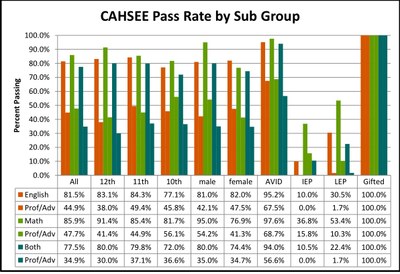
SPRING CAHSEE STATS
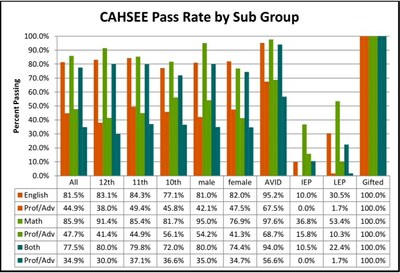
Anecdotal Data
After the Content Professional Development Session, several teachers came up to me to thank me for providing them with a refresher session on ELL strategies. They told me that when they were planning a reading activity, they “had the students make a prediction about what they were reading based on the title, major sections, and large captions” and that at the “end, [they] went back to check their prediction.” On another occasion, a couple of the English teachers told me that when they were planning their lessons, they took into consideration the Directed Reading Teaching Approaches (DRTA). Still, others mentioned that having the strategies given to them in a toolbox was helpful for them to refer to during lesson planning and instruction.
PD Evaluation Data
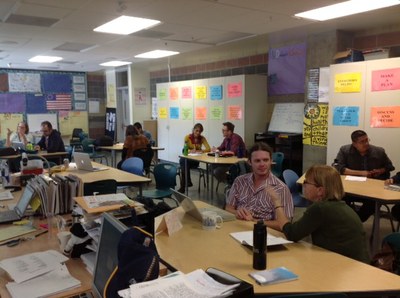 Overall, there was a consensus amongst the teachers about the efficiency of the content team professional development was positive. For the grade-level Team Professional Development, the 10th grade and 11th grade teachers completed their evaluations. In their evaluation, the 10th grade team wrote, “Making connections between WICOR and our ELLs is helpful as is sharing what we are doing in the classroom. It was somewhat difficult to categorize the WICOR strategies in our content groups, but the conversations were interesting.” The 11th grade team wrote, “helpful to share different strategies in different content areas, appreciate organization and structure of presentation.”
Overall, there was a consensus amongst the teachers about the efficiency of the content team professional development was positive. For the grade-level Team Professional Development, the 10th grade and 11th grade teachers completed their evaluations. In their evaluation, the 10th grade team wrote, “Making connections between WICOR and our ELLs is helpful as is sharing what we are doing in the classroom. It was somewhat difficult to categorize the WICOR strategies in our content groups, but the conversations were interesting.” The 11th grade team wrote, “helpful to share different strategies in different content areas, appreciate organization and structure of presentation.”
Project Observations
Others contributed to my project in several ways. All teachers participated in peer observations and creating the ELL toolbox. Michael Herrmann provided me with important school data to use in my analysis. It appears that teachers and the school are more aware of the academic shortcomings of ELLs. The school is going to implement a new plan and strategies for supporting our ELLs, specifically, the LTELs, in the following year. Furthermore, the peer observations continue to be part of the school culture. Teachers are able to learn and grow in their instruction through these practices.
The elements that did not work as planned are the parent workshop and keeping track of the ELLs that attended the tutoring labs. Part of the reason that this did not work out was partly due to time constraints and the different things that all members of the school are doing.
Two of the following short- term goals were met during the first phase of the project: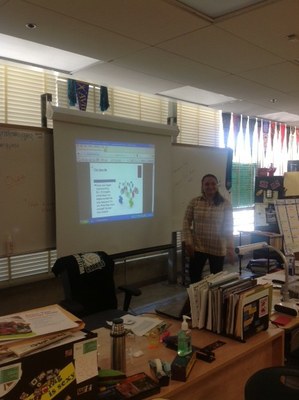
- Pre/Post staff surveys to gauge staff perspectives for teaching English language. learners. Grade-Level and Content Team peer observations for the implementation of strategies for English Language Learners.
- Increased numbers of ELLs attending tutoring labs; Increase in the percentage of students passing 15 week courses in comparison to the fall semester’s 15 week grades. (This goal was changed from 5 to 15 week grade comparisons)
- Pre/Post parent surveys to gauge parents’ understanding on the importance of reclassification for their students. (Goal not addressed)
In order for these short-term outcomes to lead to long-term benefits for ELLs, it is necessary for teachers to continually observe each other, have common planning time, and discussions about what ELL strategies are working in their classrooms that can be applied to other classes. Also, parents need to be aware of their students’ reclassification status. The school, including teachers and other staff members, need to maintain communication with the parents of ELLs and work together to support students in their reclassification process.
Changes to Future Implementation
To further support ELLs in the future, I think that it will be important to select a specific student focus group and develop an individual learning plan with strategies that help a specific student develop their English proficiency. At the same time, I think that the teachers need continuous instructional support and feedback in their lessons to ensure that the ELLs are learning. Also, parents need to be aware of the importance in their child developing English Fluency before students take the CELDT in the Fall Semester. By doing so, the parents, students, and teachers are working together form the beginning to increase the academic success of ELLs. Furthermore, I would add the CAHSEE test results as a piece of evidence to determine if ELL student achievement is improving. Lastly, I think that it is important for teachers, parents, and students to receive continuous support throughout the year and not at just once or twice during the year
To produce stronger outcomes and effectively support ELLs, it will be important to create a culture of student buy in. Students need to feel encouraged and understand why it is important for them to ask questions both in the classroom and at the afternoon labs. For this to happen, both teachers and parents need to encourage them do so, that way, they feel supported.
Final Thoughts on My Leadership Role
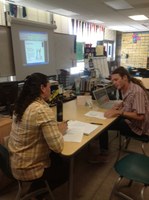 As I look back and reflect about myself as a leader with this project, I realize that I accomplished several things that I did not think I would have been able to do prior to this project. In the planning of the project, I spoke to several colleagues about what they considered was one of the most challenging aspects about teaching at ALC. To many, the number one answer was supporting our English Language Learners. Several spoke about creating lessons that they hoped to target students at various reading levels and also provide scaffolds for those who had difficulties understanding the material. After conversations with colleagues, I began gathering and analyzing data available at the school (academic performance data, CST/CAHSEE data, WASC Report, School Report Card) (CPSEL 6) and focused in particular on the achievement of ELLs. What I discovered from the data resonated with what my colleagues biggest challenge was- the lack of support for our ELLs was causing the underachievement of this group of students., After this discovery, I conducted academic research to discover what scholars said was the biggest cause of the underachievement of ELLs and my findings suggested that the three institutional causes that I have identified that are responsible for the failure of English language students are the lack of English language development resources, successful instructional strategies for student success across all content areas, and effective professional development. Thus, as I developed my project, I kept these three causes in mind. (CPSEL 1,2,3,5)
As I look back and reflect about myself as a leader with this project, I realize that I accomplished several things that I did not think I would have been able to do prior to this project. In the planning of the project, I spoke to several colleagues about what they considered was one of the most challenging aspects about teaching at ALC. To many, the number one answer was supporting our English Language Learners. Several spoke about creating lessons that they hoped to target students at various reading levels and also provide scaffolds for those who had difficulties understanding the material. After conversations with colleagues, I began gathering and analyzing data available at the school (academic performance data, CST/CAHSEE data, WASC Report, School Report Card) (CPSEL 6) and focused in particular on the achievement of ELLs. What I discovered from the data resonated with what my colleagues biggest challenge was- the lack of support for our ELLs was causing the underachievement of this group of students., After this discovery, I conducted academic research to discover what scholars said was the biggest cause of the underachievement of ELLs and my findings suggested that the three institutional causes that I have identified that are responsible for the failure of English language students are the lack of English language development resources, successful instructional strategies for student success across all content areas, and effective professional development. Thus, as I developed my project, I kept these three causes in mind. (CPSEL 1,2,3,5)
To present my project to my staff, I had several conversations with the principal and lead teachers at the school. They all agreed that something needed to be done to address the shortcomings of ELLs and that they welcomed the idea that I take on the project of addressing this concern. (CPSEL 1,2,3,5,6) Prior to the implementation of the first Professional Development geared towards addressing the underachievement of ELLs, one of the Lead Teachers had the staff read a brief article about the identified questions to answer when addressing the shortcomings of ELLs and in grade-level teams identify what we did to answer these questions. As the planning for the Content Team PD ensued, I kept in mind the article we discussed as a grade-level and searched for scholar answers to these questions. I also looked at the teacher evaluations and as a consensus, teachers wanted applicable strategies to support ELLs, thus, I looked for strategies to support the needs of the teachers in supporting our students. (CPSEL 1,2,3)
During the Content Team PD with focus on ELLs, I was nervous to present in front of my colleagues. As the youngest teacher at the school, I thought that my peers would not take me seriously and express how they have “been there, tried that, and it didn’t work.” But to my surprise, my colleagues were very supportive and engaged in the PD. Each teacher had the opportunity to reflect on their personal teaching practice, their lessons, and as content teach developed a pre and post list of strategies that they use in their classes. They each had an opportunity to share their strategies with the group as a whole in a gallery walk at the end of PD. (CPSEL 1,2,3) The teachers then set up peer observations to be done before the next content team PD.
After the first PD, I met with the principal and one of the lead teachers individually. They expressed that although they felt that the PD was well organized and provided the teachers with various strategies to implement in their lessons, that they wanted to relate them back to the AVID strategies that we had in place. I took their feedback and kept it in mind for the planning of the following PD. (CPSEL 1,2,3,5) During the planning of the following PD, “WICOR and ELL Strategies,” the teachers met in their content, grade-level, and pathways teams to discuss their strategies. (CPSEL1) The content teams first met to organize their strategies under the WICOR strategies and they then presented those strategies to their grade-level teams. The Pathways teams then identified students in their pathways who were ELL and how they could support them in their academic success. (CPSEL 1,2,3,5)
Unfortunately, in my development as a leader, I feel that I should have put other things aside and focused on ensuring that the parents of ELLs knew how they could support their student in being academically successful during their path of becoming proficient in English. (CPSEL 4) Although I kept communication the parents of my own students, more needed to be done to include the parents. I plan on ensuring that this occurs during the following academic year.
Overall, the skills that I have learned and developed from this project will be beneficial when I assume an educational leadership position. Planning and facilitating professional development based on the needs of the staff and students will be something that I can apply in the future. Most importantly, giving teachers voice and listening to the feedback of both the teachers and leaders during the development of the PD will allow for participant buy-in and cooperation. In addition, by having the opportunity of leading PD, I gained confidence in myself because I had the ability to lead a group of teachers. Furthermore, I learned the importance of basing the development of school plans on both school and scholar data. Most importantly, I was able to develop my communication skills with teachers, students, administration, and parents- a skill that is necessary to be a successful leader.
Supporting Documents
Leadership Project and References
Content Team PD PowerPoint (February 26th)

